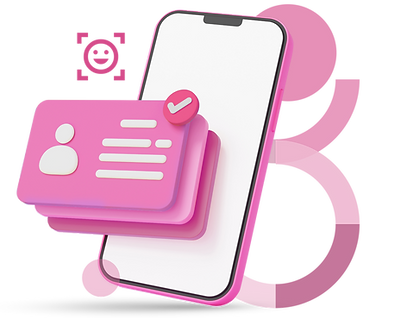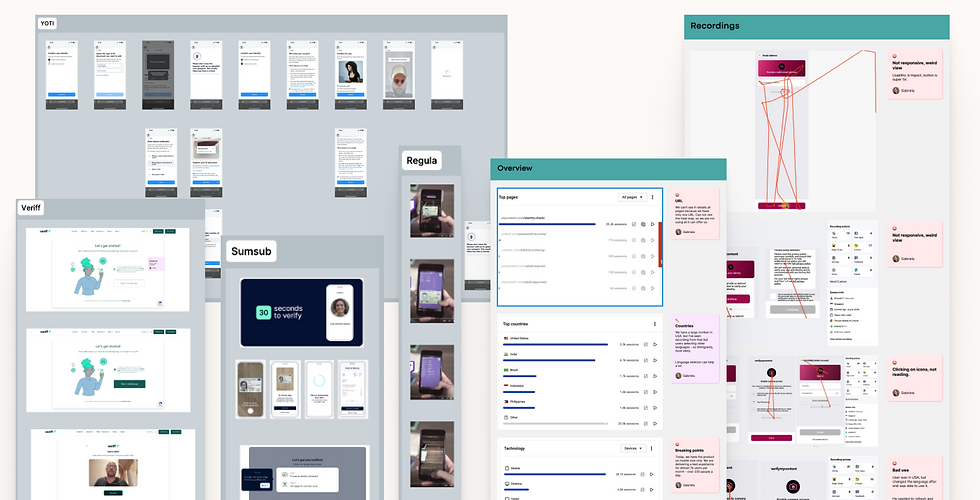Enhancing Identity Verification with Design Thinking
Role: Senior Product Designer
Year: 2024-2025

Introduction
Identity verification is a critical step in user onboarding, but when the process is complex, outdated, or frustrating, it can lead to high drop-off rates, low satisfaction, and negative brand perception.
At Verifymy, I led a Design Thinking approach to tackle these challenges, ensuring that our verification flow became more user-friendly, efficient, and aligned with client needs. The goal was to enhance the user experience, boost conversions, and strengthen client relationships by modernizing both the interface and process.
Understanding the Problem
The initial research revealed four key issues affecting the identity verification experience:
-
Declining user satisfaction: Users found the process frustrating and unintuitive.
-
High drop-off rates: Many users abandoned the flow early, leading to lost conversions.
-
Requests for a streamlined flow: Clients and users alike sought a simpler, faster experience.
-
Outdated user interface: The existing UI felt obsolete and unaligned with brand expectations.
With these challenges in mind, we saw an opportunity to transform the experience through a structured, research-driven design process.

Old UI
The Opportunity
By improving the verification flow, I aimed to achieve:
-
Higher user and client satisfaction: a smoother experience means fewer frustrations and higher engagement.
-
Increased conversion rates: reducing friction in the flow keeps users in the process.
-
Stronger brand perception: a modernized UI reflects trust, security, and professionalism.
-
Better client relationships: A more effective product enhances business partnerships and retention.
To achieve these goals, I applied the Design Thinking methodology, following a structured process of research, ideation, testing, and implementation.

Double Diamond as tool
Discovery: Understanding the Problem
We began with divergent thinking, exploring different perspectives and gathering evidence-based insights to replace assumptions with user data. Our research methods included:
-
Competitive Analysis: understanding industry best practices in identity verification.
-
User Behavior Analysis (Hotjar): observing real user interactions to identify friction points.
-
Client Flow Analysis: studying existing verification flows from client implementations.
-
Funnel Analysis (Analytics): measuring where and why users were dropping off.

Define: Refining the Insights
With extensive data collected, we synthesized findings into clear, actionable insights.
-
Comparison Tables: benchmarked solutions against competitors and industry standards.
-
Problem Definition: aligned teams on the key challenges to address.

Develop: Crafting the Solution
At this stage, we diverged again: brainstorming and exploring multiple solutions before narrowing down to the best approach.
-
User Flows: redesigned verification steps for a more intuitive journey.
-
Brainstorming & Ideation: cross-functional collaboration to generate innovative solutions.
-
Wireframes: low-fidelity concepts to test early usability.
-
High-Fidelity UI Design: crafted a modern, brand-aligned, and accessible interface.
-
Design Critiques & Iteration: ensured usability, clarity, and visual consistency before moving forward.

Deliver: Implementing the Solution
Once we had a validated design, we finalized and launched the new experience.
-
Solution Selection: identified the best-performing design direction.
-
Design Refinements: polished interactions, accessibility, and responsiveness.
-
Design Handoff: collaborated with developers for seamless implementation.
-
Tech Development: ensured the final product matched the intended user experience.

Next Steps: Continuous Optimization
Great design doesn’t stop at launch. To ensure long-term success, we plan to keep working on:
Post-Launch Monitoring
Tracking conversion rates, dropout rates, and satisfaction metrics.
User Testing
Conducting continuous testing and feedback loops.
Iterative Refinement
Enhancing the product based on real-world performance and client insights.
By applying Design Thinking, we transformed the identity verification experience into a streamlined, intuitive, and high-converting flow, making it easier for users to verify their identity while strengthening trust in the platform.

Let's get in touch!
Contact me if you're looking for a product designer or just grab a (virtual) coffee and talk about design.